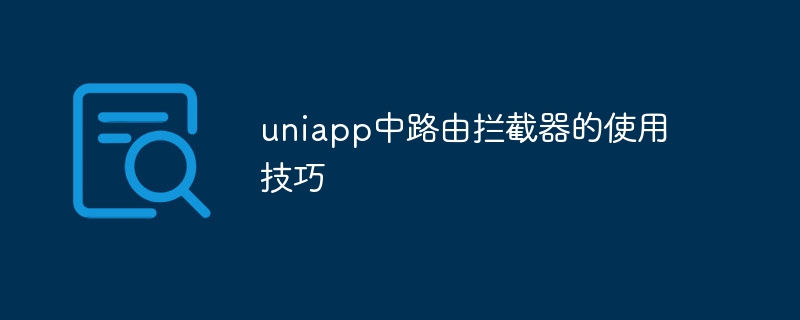

Tips for using route interceptors in uniapp
In uniapp development, route interceptors are a very commonly used function. Route interceptors allow us to perform some specific operations before routing jumps, such as permission verification, page passing parameters, etc. In this article, we will introduce the tips for using route interceptors in uniapp and provide specific code examples.
First, we need to create a route interceptor in the uniapp project. The creation method is as follows:
Create an interceptors folder in the project root directory, and then create a router.js file in the folder. The router.js file will serve as our route interceptor.
In the router.js file, we can define multiple interceptor functions through Vue.prototype.$router provided by uni-app .beforeEach method to implement route interception. The specific code is as follows:
import Vue from 'vue'
import Router from 'uni-simple-router'
Vue.use(Router)
const router = new Router({
routes: []
})
// 全局前置路由守卫
router.beforeEach((to, from, next) => {
// 在这里可以进行权限的验证,比如判断用户是否登录
// 示例:判断用户是否登录,如果没有登录,则跳转到登录页
if (!uni.getStorageSync('token') && to.path !== '/login') {
next({ path: '/login' })
} else {
next()
}
})
export default routerIn the above code example, we determine whether the user is logged in. If not, jump to the login page. Otherwise, proceed directly to the next step.
To apply the route interceptor just created in uniapp, we need to configure it in the main.js file. The specific code is as follows:
import Vue from 'vue'
import App from './App'
import router from './interceptors/router'
Vue.config.productionTip = false
App.mpType = 'app'
const app = new Vue({
...App
})
app.$mount()
// 挂载路由
Vue.prototype.$router = routerIn the above code example, we introduced the created routing interceptor through import and mounted it to the Vue instance through the Vue.prototype.$router method.
Now, we can perform route jump operations in uniapp and trigger route interceptors. The specific code example is as follows:
// 在页面中通过点击按钮进行路由跳转操作
<template>
<view>
<button @click="gotoLogin">跳转到登录页</button>
</view>
</template>
<script>
export default {
methods: {
gotoLogin() {
uni.navigateTo({
url: '/pages/login/login'
})
}
}
}
</script>In the above code example, we use the uni.navigateTo method to perform routing jump operations and specify the page to jump to.
Through the above steps, we have completed the use of routing interceptor in uniapp. By defining interceptor functions and configuring them, we can perform permission verification and other operations before routing jumps, thereby improving application security and user experience.
Summary
This article introduces the usage skills of routing interceptors in uniapp and provides specific code examples. By using route interceptors, we can perform some specific operations before routing jumps, such as permission verification, page passing parameters, etc. In uniapp development, reasonable use of route interceptors will bring us a better development experience and user experience.
The above is the detailed content of Tips for using route interceptors in uniapp. For more information, please follow other related articles on the PHP Chinese website!




